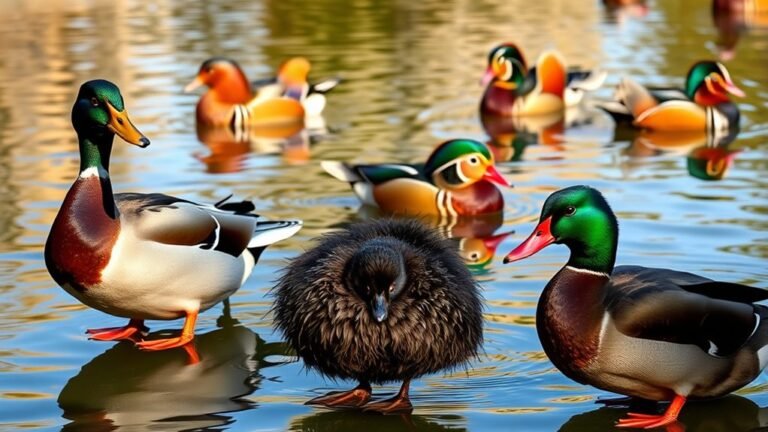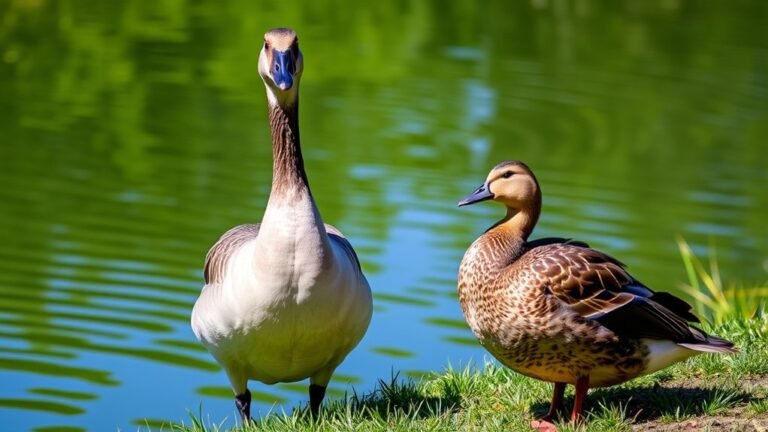Egret Vs Heron: Understanding the Differences
When you see egrets and herons, you might think they look the same because of their long legs. But there are important differences between them! They like different places and hunt in unique ways.
Egrets usually prefer shallow water and often stand still waiting for fish or frogs. They are known for their white feathers, which make them stand out. Herons, on the other hand, can have grey, blue, or white feathers and often wade through deeper water while hunting.
Both birds are part of the Ardeidae family and play important roles in nature. They help keep ecosystems balanced by controlling fish and insect populations. By watching their behaviors, you can learn more about how they fit into their habitats. What interesting things will you find out about these two birds?
A Quick Overview
Egrets and herons look quite different. Egrets are usually white and have thinner bodies. In contrast, herons come in various colors and have sturdier builds.
Egrets like to live in freshwater wetlands. Herons can be found in both freshwater and salty places.
In size, egrets are about 24 to 38 inches tall. Herons are taller, ranging from 30 to 54 inches.
When it comes to food, egrets mostly eat insects and small fish. Herons go for larger fish and amphibians, like frogs.
Egrets like to nest in groups using soft materials. Herons build bigger nests alone or in colonies, using sticks.
So, just remember: egrets are white and thin, while herons come in different colors and are sturdier. Egrets prefer fresh water, and herons can adapt to various water types. And they each have their own unique eating and nesting habits!
Overview of Egrets and Herons

Egrets and herons are both part of the same family called Ardeidae, but they look and act quite differently. Egrets are usually white and eye-catching, like the Great Egret. Herons, such as the Great Blue Heron, come in many colors and sizes.
Where they live matters a lot too. Egrets like freshwater wetlands, while herons can live in both freshwater and saltwater areas. You'll find egrets mostly in warmer places, while herons are more widespread.
Even with these differences, egrets and herons share some behaviors. They both have similar ways of finding food and building nests, showing that they come from the same family.
Learning about these differences and similarities can help you appreciate these amazing birds even more!
Physical Characteristics
Egrets and herons are both beautiful birds, but they look a bit different. Egrets usually have a thinner body, which helps them fly quickly and catch food. Their wings are long and elegant, making them glide smoothly over wetland areas.
On the other hand, herons have a sturdier body. This helps them keep their balance while standing in the water. Their wings are also long, but they're wider, which gives them a strong lift when they take off to hunt for their meals.
Both egrets and herons have similar beaks that help them catch fish. The differences in their bodies and wings show how they're specially suited for their homes.
Taking the time to notice these features helps us understand how important each bird is to its environment.
Size Comparison

Egrets and herons are both birds that belong to the same family, but they come in different sizes. Egrets are smaller, standing about 24 to 38 inches tall.
On the other hand, herons are bigger and can reach heights of 30 to 54 inches, depending on the type.
Their size affects how they behave and where they like to live. Egrets usually hunt in shallow waters. Their smaller size helps them move quickly.
Herons, with their longer legs, prefer to wade in deeper water.
Knowing how these birds differ in size can help you appreciate what they do in nature. Watching them in the wild can show you how size changes how they interact with their surroundings.
This makes spotting egrets and herons even more fun!
Plumage and Color Patterns
Egrets and herons look different because their feathers and colors help them survive in their homes. Egrets are known for their bright white feathers. These white feathers make them appear pure and graceful. They use their color to attract mates and to hide in the sunlit areas of wetlands.
Herons have many colors, like deep blues and slate grays. These colors help them blend in with their surroundings. This camouflage is important because it allows herons to catch fish and other prey without being seen.
By looking at the colors and patterns of egrets and herons, we can understand how these birds fit into their environments. Their feathers tell us a lot about their habits and how they live in nature.
When we appreciate their colors, we learn more about their unique roles in the ecosystem.
Beak Shapes and Sizes

Egrets and herons are both birds in the same family. They've different beak shapes and sizes that help them find food in their homes.
Egrets have long, thin beaks. This helps them catch small fish and tiny animals in shallow water. They often look for food in places where they can see everything clearly.
Herons have strong, pointed beaks. These are good for spearing bigger animals like frogs and fish. Herons are sneaky hunters. They move quietly and quickly to catch their meals.
Habitat Preferences
Egrets and herons like to live in different places that suit their needs. Egrets prefer shallow wetlands like marshes, swamps, and coastal areas. These spots are perfect for them because they've good nesting places and plenty of fish and other aquatic creatures to eat.
Herons are a bit more flexible. They can live in wetlands, but they also do well in cities. You might see them standing in ponds or near rivers, showing that they can adapt to busy environments where people live.
Both egrets and herons need water and shelter, but they choose their homes based on what works best for them. Knowing where these birds like to live helps us see how they fit into their surroundings, whether it's a calm wetland or a lively urban area.
Feeding Habits
Egrets and herons both eat in similar ways, but they've some differences in how they catch their food and what they like to eat.
Egrets usually use different methods to find their meals. Here are some of the ways they hunt:
- Standing still: Egrets often wait quietly to catch their prey by surprise.
- Stalking: They move silently to get close to their target before they strike.
- Chasing fish: If needed, egrets quickly chase after fish.
- Eating insects and small animals: They also enjoy snacks like insects and small mammals, not just fish.
Herons, on the other hand, eat a wider variety of foods. They go after different sizes of fish and like to eat amphibians too.
Breeding Behavior
Egrets and herons have interesting ways of finding mates. During courtship, they show off with cool moves like flapping their wings, stretching their necks, and dancing together.
These actions help them attract partners and build strong connections for raising their babies.
When it comes to nesting, they've different preferences. Egrets like to nest in groups, often using trees or bushes.
Herons might choose to build their nests alone or join others in a colony.
Learning about how egrets and herons breed gives us a greater understanding of their lives and shows how amazing these birds are.
Nesting Habits
Egrets and herons both like water, but they nest differently. This difference helps them thrive in their environments.
Egrets usually like to build their nests alone. They choose soft grasses, reeds, and small branches to make cozy homes. These nests are often placed high in trees or shrubs, which helps protect them from predators.
On the other hand, herons like to be social. They build bigger nests using sticks and twigs, making strong homes that can hold several young herons. They often gather in colonies in wetlands and in tall trees, enjoying the company of other herons.
These nesting habits show how egrets and herons adapt to their surroundings. Each bird has its own way of living and surviving.
Vocalizations
Egrets and herons have unique ways of showing their behavior. One way they do this is through their sounds. If you listen carefully, you'll find that egrets don't make as many different sounds as herons do. Egrets usually make soft squawks and low calls, especially when they're nesting or showing off.
Herons, on the other hand, make many different kinds of sounds. They can croak, honk, and do all sorts of calls. These sounds help them during mating and when they want to claim territory. The way they vocalize tells us a lot about their behavior and the places they live.
Understanding these sounds helps us appreciate how egrets and herons fit into nature. So, the next time you're outside, take a moment to listen to their calls. It's a nice way to feel connected to the world around you.
Migration Patterns
Egrets and herons live in similar places, but they migrate differently. Environmental factors shape their movements. Egrets travel long distances to warmer places during the cold months. In contrast, herons usually move shorter distances and stay near their breeding areas.
Here are some key differences:
- Nesting migrations: Egrets fly to warmer places, often going far away.
- Seasonal movements: Herons like to stay close to where they breed and migrate less.
- Timing: Egrets might start their migration before herons.
- Habitat: Egrets like wetlands, whereas herons can live in many types of environments.
Knowing how these birds move helps us understand their roles in nature. Each bird shows how well animals can adapt to their surroundings.
Conservation Status
Understanding the migration patterns of egrets and herons can help us learn about their conservation status. These birds face big challenges, mainly because their homes are disappearing. This happens due to urban development, farming, and climate change.
Habitat protection is very important for their survival. Wetlands are crucial as they provide places for egrets and herons to breed and feed.
By helping out with conservation projects and using land in a smart way, you play a part in protecting these beautiful birds.
Getting the community involved is key. When people care about birds, they feel connected to nature.
Together, we can tackle the challenges that egrets and herons face and work toward a brighter future for them in our environment.
Frequently Asked Questions
How Do Egrets and Herons Interact With Each Other in the Wild?
Egrets and herons often live in the same places, like wetlands and lakes. They both look for food in the water, which can include fish and small animals. While they hunt, you might see them working close to each other.
However, when it comes to building nests, they have different preferences. Egrets like to nest in groups with other egrets. They enjoy being part of a busy colony. On the other hand, herons usually prefer to build their nests alone or in small groups.
This difference in nesting shows how both birds have found their own ways to thrive in the same environment. Watching egrets and herons together can be a fascinating experience!
Are Egrets and Herons Endangered Due to Human Activity?
Egrets and herons are in trouble. They face big threats like losing their homes and being hunted. These issues can harm their numbers. We need to work together to help protect them. This will keep nature in balance and help these beautiful birds survive.
What Are the Common Myths Surrounding Egrets and Herons?
Many people believe some common things about egrets and herons. These birds often stand for purity and patience in different cultures. However, people sometimes think they are the same bird with the same habits. This is not true.
Egrets and herons look a bit alike, but they are different. They have different sizes, colors, and styles of hunting. It's important to know these differences to appreciate each bird for what it is.
Can Egrets and Herons Be Kept as Pets?
Egrets and herons are not good pets. They have special needs and unique behaviors that make them hard to care for at home. These birds do best in their natural environments. Keeping them in a cage can harm their health and happiness. It's important to let these birds live freely where they belong.
How Can One Differentiate Juvenile Egrets From Juvenile Herons?
To tell juvenile egrets apart from juvenile herons, you can look at their colors and feather patterns. Juvenile egrets usually have a soft, white or light gray color. In contrast, juvenile herons tend to be darker and often show unique markings on their feathers.

Luna is the passionate founder and author of Birds and You, a website dedicated to sharing her love for birds with fellow enthusiasts. Through her engaging articles and guides, she aims to educate and inspire others to explore the fascinating world of birds. When she’s not writing, you can find Luna observing birds in their natural habitats or sharing beautiful bird photography on Pinterest. Join her on this journey to celebrate and protect our feathered friends!







